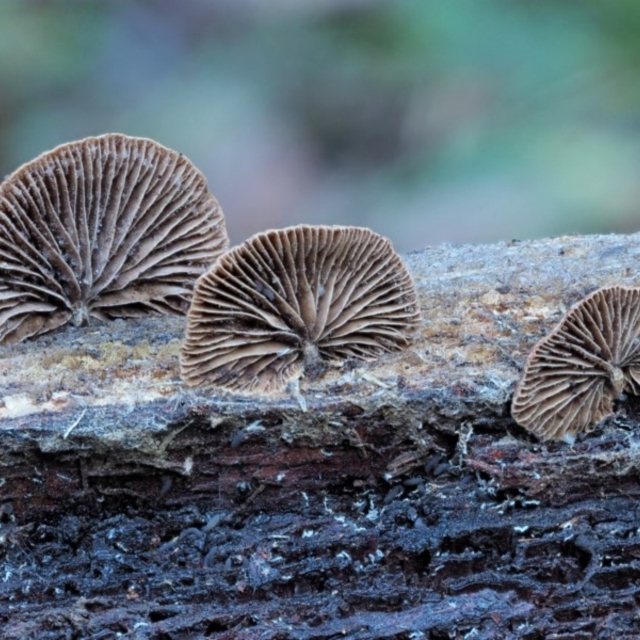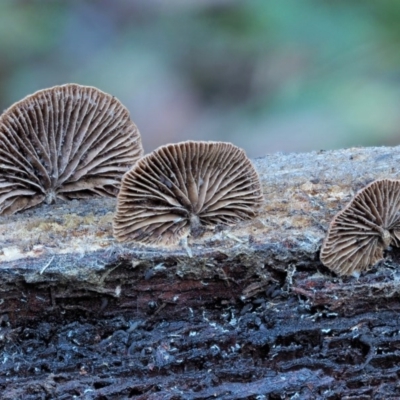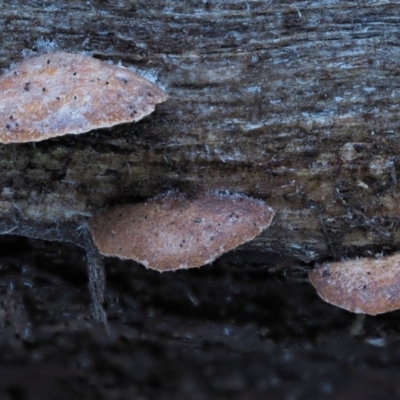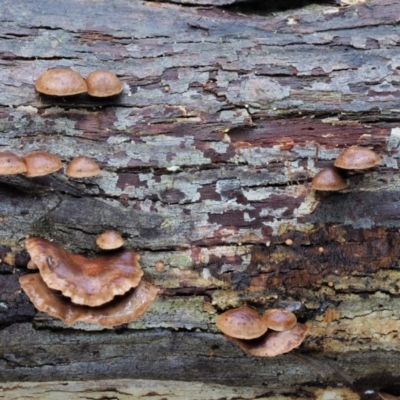Deconica horizontalis
<p class="MsoNormal" style="margin-bottom: .0001pt; line-height: normal;">The fruitbody is a mushroom with a cap supported by a markedly off-centre stem. The fan-shaped cap may be up to 2 centimetres wide and is rusty brown to darkish brown but pale brown on drying. It is a little hairy when young but smoother with age. The gills are brown. The stem may be up to 3 millimetres long, is brownish and covered by a whitish bloom. It is a little fluffy or furry at the base.</p>
<p class="MsoNormal" style="margin-bottom: .0001pt; line-height: normal;"> </p>
<p class="MsoNormal" style="margin-bottom: .0001pt; line-height: normal;">Spore print: purplish brown or dark brown.</p>
<p class="MsoNormal" style="margin-bottom: .0001pt; line-height: normal;"> </p>
<p class="MsoNormal" style="margin-bottom: .0001pt; line-height: normal;">The mushrooms appear on live or dead wood, usually in groups. Noordeloos (see below) notes that the species has also been found on "various anthropogenic substrates like mattress coverings, cocos mats, newspaper, cardboard boxes, etc".</p>
<p class="MsoNormal" style="margin-bottom: .0001pt; line-height: normal;"> </p>
<p class="MsoNormal" style="margin-bottom: .0001pt; line-height: normal;"><strong style="mso-bidi-font-weight: normal;">Look-alikes</strong></p>
<p class="MsoNormal" style="margin-bottom: .0001pt; line-height: normal;"><em style="mso-bidi-font-style: normal;">Crepidotus</em> is a common genus in which the fruitbodies are fan-shaped mushrooms that grow from wood but they either lack stems or have barely visible ones - and the spore print is a rusty brown. <em style="mso-bidi-font-style: normal;">Panellus stipticus</em> (another producer of short-stemmed, brown, fan-shaped mushrooms) is known from the ACT but gives a white spore print.</p>
<p class="MsoNormal" style="margin-bottom: .0001pt; line-height: normal;"> </p>
<p class="MsoNormal" style="margin-bottom: .0001pt; line-height: normal;"><strong style="mso-bidi-font-weight: normal;">Reference</strong></p>
<p class="MsoNormal" style="margin-bottom: .0001pt; line-height: normal;">Noordeloos, M.E. (2011). <em style="mso-bidi-font-style: normal;">Strophariaceae s.l.</em>, Edizioni Candusso, Alassio. </p>,<p> </p>
<p class="MsoNormal" style="margin-bottom: .0001pt; line-height: normal;">The fruitbody is a mushroom with a cap supported by a markedly off-centre stem. The fan-shaped cap may be up to 2 centimetres wide and is rusty brown to darkish brown but pale brown on drying. It is a little hairy when young but smoother with age. The gills are brown. The stem may be up to 3 millimetres long, is brownish and covered by a whitish bloom. It is a little fluffy or furry at the base.</p>
<p class="MsoNormal" style="margin-bottom: .0001pt; line-height: normal;"> </p>
<p class="MsoNormal" style="margin-bottom: .0001pt; line-height: normal;">Spore print: purplish brown or dark brown.</p>
<p class="MsoNormal" style="margin-bottom: .0001pt; line-height: normal;"> </p>
<p class="MsoNormal" style="margin-bottom: .0001pt; line-height: normal;">The mushrooms appear on live or dead wood, usually in groups. Noordeloos (see below) notes that the species has also been found on "various anthropogenic substrates like mattress coverings, cocos mats, newspaper, cardboard boxes, etc".</p>
<p class="MsoNormal" style="margin-bottom: .0001pt; line-height: normal;"> </p>
<p class="MsoNormal" style="margin-bottom: .0001pt; line-height: normal;"><strong style="mso-bidi-font-weight: normal;">Look-alikes</strong></p>
<p class="MsoNormal" style="margin-bottom: .0001pt; line-height: normal;"><em style="mso-bidi-font-style: normal;">Crepidotus</em> is a common genus in which the fruitbodies are fan-shaped mushrooms that grow from wood but they either lack stems or have barely visible ones - and the spore print is a rusty brown. <em style="mso-bidi-font-style: normal;">Panellus stipticus</em> (another producer of short-stemmed, brown, fan-shaped mushrooms) is known from the ACT but gives a white spore print.</p>
<p class="MsoNormal" style="margin-bottom: .0001pt; line-height: normal;"> </p>
<p class="MsoNormal" style="margin-bottom: .0001pt; line-height: normal;"><strong style="mso-bidi-font-weight: normal;">Reference</strong></p>
<p class="MsoNormal" style="margin-bottom: .0001pt; line-height: normal;">Noordeloos, M.E. (2011). <em style="mso-bidi-font-style: normal;">Strophariaceae s.l.</em>, Edizioni Candusso, Alassio. </p>
Deconica horizontalis is listed in the following regions:
Canberra & Southern Tablelands
Species information
- Deconica horizontalis Scientific name
- Common name
- Not Sensitive
- Local native
- Non-invasive or negligible
- Machine learning








